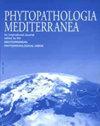Characterization of Colletotrichum strains associated with olive anthracnose in Sicily
IF 1.9
3区 农林科学
Q2 AGRONOMY
引用次数: 1
Abstract
Anthracnose caused by Colletotrichum spp. is the most damaging olive fruit disease in many countries, including Italy. This disease has been sporadically detected in Sicily, but new agronomic practices can increase risk of olive anthracnose in this region. An etiological study of the disease focused on local olive cultivars growing at the International Olive Germplasm Collection (IOGC) in Villa Zagaria, Enna, Sicily has been undertaken. During 2018 and 2019, 137 Colletotrichum strains were isolated from olives. Colony morphology, conidium characteristics, and multilocus sequence analyses aided identification of three species: C. acutatum (affecting 70% of symptomatic olives), C. gloeosporioides, and C. cigarro. Three C. acutatum strains (B13-16, P77, and P185), and one strain of each C. gloeosporioides (C2.1) and C. cigarro (Perg6B) were evaluated for pathogenicity on olive fruits from 11 Sicilian cultivars, known for their high-quality oil. Differences in virulence were detected among strains and their pathogenicity to the cultivars. The C. acutatum isolates were more virulent than those of C. gloeosporioides or C. cigarro. The Sicilian olive cultivars Cavaliera, Carolea, Calatina, and Nocellara del Belice were the most susceptible to the pathogen, while the cultivars Biancolilla and Nocellara Etnea were the most tolerant. Cultivar response under field conditions showed that anthracnose severity and fruit-rot incidence were positively correlated. This is the first report of C. acutatum and C. cigarro affecting olive trees in Sicily. Control measures for anthracnose depend on accurate characterization of the etiological agents and host cultivar resistance.西西里岛橄榄炭疽病相关炭疽菌的鉴定
炭疽病是包括意大利在内的许多国家最具破坏性的橄榄果实疾病。这种疾病在西西里岛偶尔被发现,但新的农艺措施会增加该地区橄榄炭疽病的风险。在西西里岛恩纳的Villa Zagaria的国际橄榄种质资源收藏馆(IOGC),对当地橄榄品种进行了该疾病的病原学研究。2018年至2019年间,从橄榄中分离出137株炭疽菌。菌落形态、分生孢子特征和多点序列分析有助于鉴定三个物种:尖尖尖橄榄(影响70%有症状的橄榄)、球孢C.gloeosporioides和cigarro。对三株尖尖尖孢C.acutatum菌株(B13-16、P77和P185)以及球孢C.gloeosporioides(C2.1)和cigarro(Perg6B)各一株菌株对11个西西里品种的橄榄果实的致病性进行了评估,这些品种以其高质量的油而闻名。菌株之间的毒力及其对品种的致病性存在差异。尖孢C.acutatum分离株的毒力强于球孢C.gloeosporioides或cigarro分离株。西西里橄榄品种Cavaliera、Carolea、Calatina和Nocellara del Belice对病原体最敏感,而品种Biancolilla和Nocellera Etnea对病原体最耐受。田间试验结果表明,炭疽病的严重程度与果实腐烂病的发生率呈正相关。这是第一份关于C.acutatum和C.cigarro影响西西里岛橄榄树的报告。炭疽病的控制措施取决于病原体和寄主品种抗性的准确鉴定。
本文章由计算机程序翻译,如有差异,请以英文原文为准。
求助全文
约1分钟内获得全文
求助全文
来源期刊

Phytopathologia Mediterranea
生物-植物科学
CiteScore
4.40
自引率
8.30%
发文量
28
审稿时长
6-12 weeks
期刊介绍:
Phytopathologia Mediterranea is an international journal edited by the Mediterranean Phytopathological Union. The journal’s mission is the promotion of plant health for Mediterranean crops, climate and regions, safe food production, and the transfer of new knowledge on plant diseases and their sustainable management.
The journal deals with all areas of plant pathology, including etiology, epidemiology, disease control, biochemical and physiological aspects, and utilization of molecular technologies. All types of plant pathogens are covered, including fungi, oomycetes, nematodes, protozoa, bacteria, phytoplasmas, viruses, and viroids. The journal also gives a special attention to research on mycotoxins, biological and integrated management of plant diseases, and the use of natural substances in disease and weed control. The journal focuses on pathology of Mediterranean crops grown throughout the world.
The Editorial Board of Phytopathologia Mediterranea has recently been reorganised, under two Editors-in-Chief and with an increased number of editors.
 求助内容:
求助内容: 应助结果提醒方式:
应助结果提醒方式:


